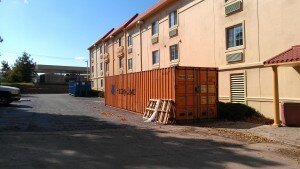Six Questions for Picking your Container Delivery
We have talked about what size container, how you want it delivered and even if you should put blocking under your container, but we have not talked about one of the most important things you should do before you get your container—prep your container delivery spot. So today we will remedy this. Here are six questions that will help you make sure you have a good spot for your container and that delivery will go smoothly.
1. Where is your container going to go? Clearly you need to have enough space for the container itself. But remember you also need to be able to open the doors and access those doors. The doors do open full so the doors can be flush with the container. However, this is the first big question. Where do you have for it? You probably have considered this, but if not, now is the time.
2. How will a truck access this spot? Some spots are easy – in a large parking lot, at the end of a long, straight driveway. Others are trickier – in a backyard, in a remote location, etc. Remember that trucks are large and not as nimble as a car. Most delivery trucks are a tractor-trailer combination with a 45’ trailer connected to a tractor/cab of the truck. While it can “bend” in one spot, it does need plenty of room to turn from the street and to maneuver into place. Also, trucks cannot drive through field, on soft ground, etc.
3. Is there enough room to off-load the container? Most ground-level delivery of containers is done off the back of the truck. The truck will back into the spot where the container will go. The back of the trailer tips down and the driver uses in a winch to lower the first end of the container off the truck and onto the ground. The driver then pulls the truck forward and uses the winch to finish setting the container on the ground. This means there needs to be enough space for the container plus the length of the truck, plus enough room for the truck to turn or pull out of that spot. In general, that means 130’ for a 40’ container and 110’ for a 20’ container. The driver can load the container, so the doors are the first or last thing off the truck, so no need to worry about that.
4. Is the delivery area relatively flat? The physics of delivering a container use gravity. If delivery is done on a sloped ground, that can be dangerous for the driver, truck and container and can damage your property. When containers are being offloaded, they push both down and sideways on the truck, so it is important that the truck can properly unload the container.
5. Is the ground firm enough? Ideally, the container would be placed on concrete or asphalt. If that is not possible, gravel makes a great firm surface. 20’ containers weigh 5,000 pounds and 40’ containers weight 9,200-9,600 pounds (depending on standard or high cube). Those are empty weights. If you place a container on soft ground, it will sink in. If you don’t have any of the above, we recommend putting in gravel. Not only is it the cheapest and easiest option, it is also the quickest to be ready for a container. Laying concrete or asphalt requires a wait time while the slab cures.
Forklifts and other equipment can move containers around
6. What if you don’t have all of these requirements? If you don’t, do you have a spot that would work, but just not be where you want the container? One option is to have the container dropped there and then hire an equipment handling company (the company that will bring out cranes and other equipment to move your container) move the container into spot. This is particularly helpful when you want the container to go in a backyard or a more remote location.
Hopefully, these questions will help you make sure your container is safely delivered and you are happy with where your container is set down.




